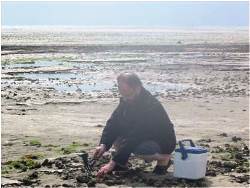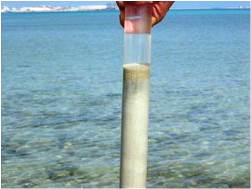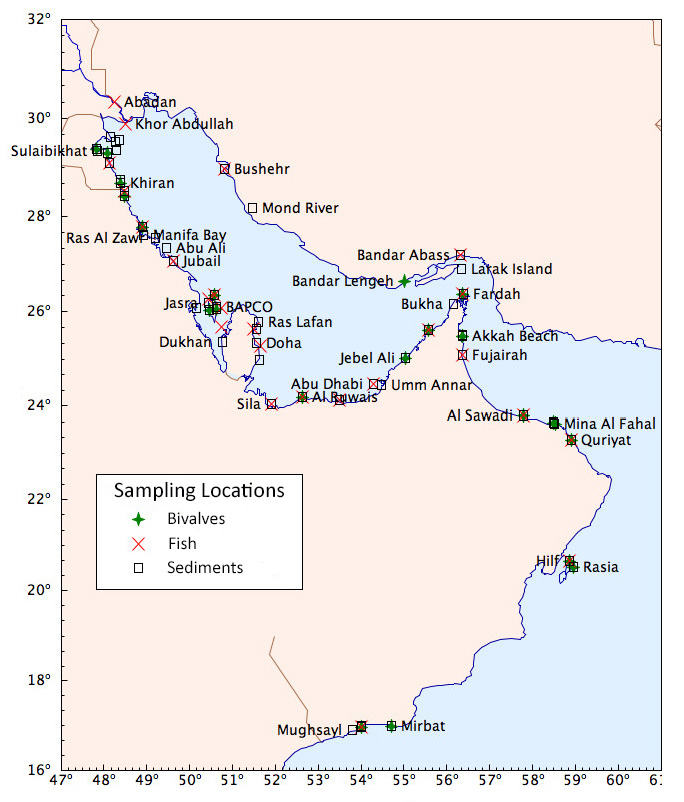Specifically, surveys of heavy metal and organic contaminants in sediments and biota have taken place in Bahrain, Kuwait and UAE (June 1994), in I.R. Iran, Oman and Qatar (1997), in Kuwait and Saudi Arabia (October 1998 in Qatar and March 2000 in UAE, in Bahrain (November 2000) and in Oman (August 2001), in addition to the comprehensive survey undertaken between February-March 2005 for the same target analytes in the key coastal sites of all ROPME- Member States. In addition, estimation of Methyl Mercury in sediments and biota carried out during 1994 (Bh-Ku-UAE) and 1998 (Ku- SA); Organotin in sediments and biota during 2000-2001 (Bh- Qa- UAE- Oman) and Faecal Sterols in sediment during 1994 (Bh-Ku-UAE) and 1998 (Ku-SA).



Survey Highlights
Trace Metals
- The majority of trace metals concentrations in sediments and biota correspond to natural background levels in marine environments
- Mercury concentrations continue to be very low in sediment and the observed total Hg levels in fish (Hamoor) maintained to be below the 0.5 µg g-1 (wet wt) threshold
- Unexplained high concentrations of Arsenic have been maintained in some bivalves during 1994-2005
- Nickel and Chrome dominant in high concentration in almost all collected inter-tidal sediments
- Examples of Obtained Results:
Petroleum Hydrocarbons
- With few exceptions in RSA, the general temporal trend of levels of Petroleum Hydrocarbons (PHC) in sediments & biota have been decreased during the period 1994-2005.
- Levels of PCH in Sediments lie actually within the permissible level for the Region (15µg/g, as CEU).
- Chronic PHC pollution in RSA prevails in the vicinity of the BAPCO industrial complex (Bahrain), at Mina al Fahal (Oman) and to lesser extent in the surroundings of Sulaibikhat & Doha Bay (Kuwait).
- PHC concentrations in biota have decreased to values reported before the 1991 War.
- Prevailed PHC levels in fish and bivalves are actually comparable to those concentrations observed in relatively unpolluted areas elsewhere in the world.
- The historical high levels in Oysters from Mina al Fahal (Oman) and around Akkah Head (UAE) are still maintained.
Chlorinated Hydrocarbons
- Generally, concentrations of DDTs and PCBs in sediments and biota maintain their extremely lower levels than global standers during 1994-2005.
Methyl Mercury
- In both 1994 & 1998 surveys, muscles of big fishes contained high concentrations of total Hg(T. Hg) and Me-Hg similar to these reported in previous surveys in the Region (in mid-1980 and 1993-94)
- Highest measure levels of Hg found in fishes from Kuwait in both surveys (in Bubiyan,1994 and in S. Kuwait,1998)
- Usually, Methyl Mercury (Me-Hg) comprised the bulk of T. Hg in fish muscles from the Region
- Generally, Hg levels in fish muscles not exceeded 0.5 mg/kg -wet wt (permissible consumption limit)
- Bivalves usually characterized by Hg and Me-Hg levels less than found in fishes and higher that those in sediments with much lesser amount of Me-Hg in T. Hg
Organotin Compounds
- In Sediments, Tetrabutyl Tin (TBT) found in significant amounts at Jebel Ali port (UAE), Umm Said, Dukhan (Qatar), and off BAPCO (Bh.)
- In Bivalves, TBT, DBT and TPhT presented with much higher levels in Pearl oysters from Abu Dhabi (UAE) and off BAPCO in Bh. In Rock oysters, Total Butyltins and TBT were relatively low except in Akkah Beach and Abu Dhabi in UAE and Hilf in Oman, reflecting detected high levels in their surrounding sediments
- In Fish, TBT was low in most of analyzed fish .Exceptions were detected in muscle of some species from Badaiya (Bh), Umm Said and Doha (Qatar) and Quriyat (Oman). The derivatives Diphenyltin (DPHT) and Triphenyltin (TPHT) are detected in grouper from Al Khawr (Qatar)
Faecal Sterols
- Survey of 1994 identified sewage contamination, only at Shuwaikh Bay in Kuwait and to lesser extent at Jasra (Bahrain).
- Sediments from Iran, Oman and Qatar (1997) and from SA in 1998 didn’t indicate significant domestic pollution ( Corpostanol < 100 ng/g
- During 2000-01 survey , levels of Sterols, as Corpostanol, kept their low levels in sediments from UAE, Qatar and Oman with relatively higher conc. (around 200 ng/g) in one site in each country